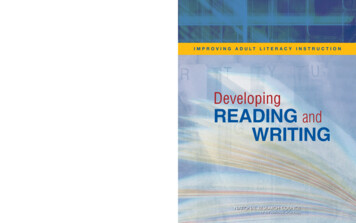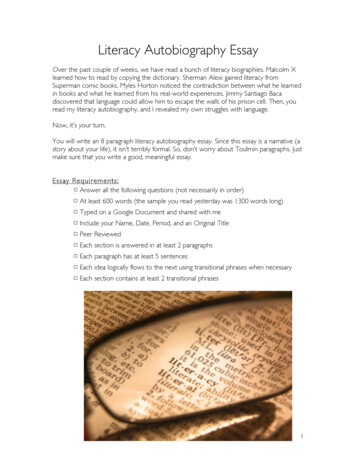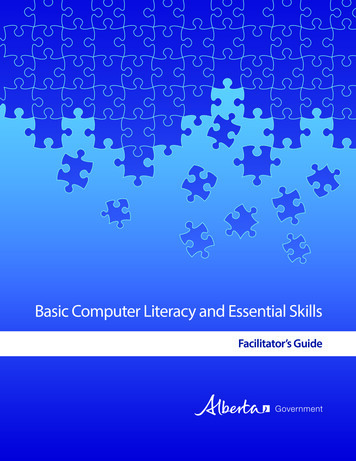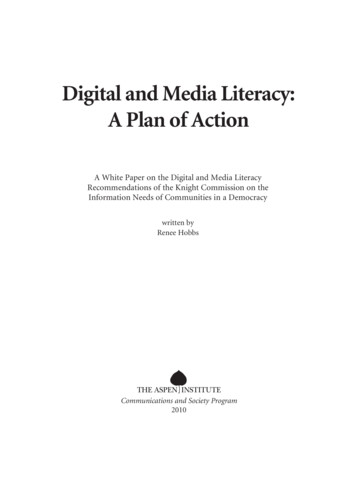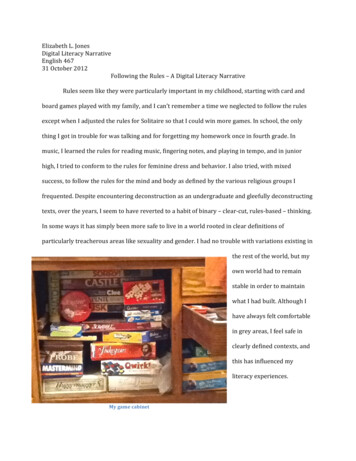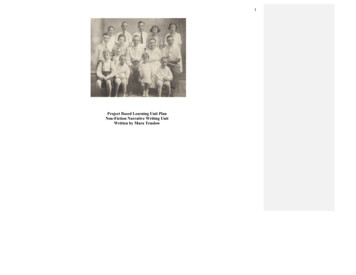
Transcription
Strategies for Improving Literacy for Students with ASDThe following information may be helpful in building literacy skills for young and elementary aged students with ASD. This includes resources on the STARTLiteracy web page, texts by authors who specialize in literacy and ASD, and online resources that support the outlined strategies. Noted in the followingare characteristics that impact literacy for students with ASD, areas for possible intervention, one or more strategies for implementing the intervention,and resources where noted strategies can be found. An overview of literacy practices, skills, and reading profiles also are covered.Inclusive Literacy Practices (START Literacy & ASD Presentation)There are universally accepted strategies and practices that are embedded throughout the following options for teaching literacy to students with ASD.Consider these points as the strategies are designed and implemented for students and classrooms. Keep expectations high and continually move the bar as the student progresses. Elicit student perspectives by using their personal interests, fascinations, passions to promote interest and engagement in reading. Use flexible grouping strategies, diversity, and differentiated instruction based on the need of the student. Use elastic instructional approaches as a basis for all literacy instruction.- Visual Supports.- Priming for background knowledge.- Peer models of literate behavior and partners in paired reading situations.- Use student interests, fascinations, and passions to promote interest and engagement in developing literacy skills.- Engage readers before, during, and after reading.- Use interactive approaches such as literacy software, applications, websites, books, and PowerPoint presentations. Focus on emergent literacy skills progressing to more complex skills. Practice-practice-practice as vocabulary requires multiple exposures to be fully learn, be maintained, and generalize (Carnahan & Williamson, 2011, p.332). When using reward systems, assure the reward is reinforcing to the individual. This will vary from student to student, class to class, and even day today. If the student has gotten too much of a reward, they may be tired of it so change rewards, fade rewards slowly, keep rewards more frequent anddesirable for new and difficult skills being learned. If using the suggested texts and resources for strategies, note whether the resource was designed specifically for students with ASD. Somemodification of the comprehension strategy may need to take place to differentiate for needs of the specific student and to maximizeeffectiveness.Emerging Literacy and Students with ASD (Carnahan & Williamson, 2010; Island & Smith-Myles, 2011)START: Strategies for Improving Literacy for Students with ASD1
The following outlines emergent literacy skills to subsequently teach expanded literacy skills and reading comprehension. Also, literacyconsiderations for students with ASD from 4th grade forward.Emergent LiteracyEmergent Literacy(Carnahan & Williamson, 2010, p. 222)A. Decoding: awareness and recognition of structure ofprint including meaning and function of print.Individual unit of written language a letter(grapheme); one or more sounds associated with oneor more letters (phoneme).a. Phonological awareness: recognize and buildsound properties of words.b. Alphabet knowledge: can receptively identifyletters, expressively name letters, match letters tosoundsc. Print concepts: understanding the forms,functions, and features of print; direction,organization, and meaning of print (e.g.understand genres of print are different such ascoupons are for shopping and storybooks are forentertainment); understand letters make upwords.d. Emergent writing: attempts to convey informationthrough written symbols; writing progresses fromdrawing and scribbling to letter like formations tocomplete letters.(Carnahan & Williamson, 2010, p. 222)B. Comprehension: global understanding ofprinted words and sentences. Languagecomprehension of semantic and syntacticrelationships of and between words.a. Vocabulary: understands meaning ofwords.b. Grammatical understanding:understanding of basic syntax of wordsand sentences; understands varioussentence types and clause structures andwhen reading uses this information forcomprehension.c. Narratives: oral or written description ofan event and may be personal account orfictional retellings of a story. Topic ispresented by the speaker or writer andsequence of events are linked together.Expanding Literacy(Island & Smith-Myles, 2011. p. 48)A. Use of context: ability to determinecorrect meaning of words andunderstanding homographs through selfmonitoring and self-correction; maycontinue reading even if text does notmake sense; figuring out meaning fromunknown words; ability to integrateinformation from background knowledge.B. Pronouns: understanding pronouns inprint and stopping to clarify meaning(called anaphoric cuing).C. Questioning: asking questions before,during, and after reading and central tocomprehension. Prerequisite for morecomplex strategies and thoughtprocesses.D. Auditory comprehension of spoken (oral)language: ability to understand academicinstruction. Translates to ability tounderstand written language.Literacy Skills Needs: 4th Grade Forward (Island & Smith-Myles, p. 75)Many literacy issues not recognized earlier present in 4 th grade with comprehension challenges as more advanced thinking and learning is required from 4 th grade on.Readers must apply what they are reading to discussions, writing assignments, and other work.A. Missing prerequisite skills and uneven development of literacy skills.B. May have traditional strong decoding skills.C. Comprehension issues impact more than one area.D. Behavioral issues may develop and could be side effects of underlying comprehension issues. This includes changes in frustration level, anxiety, answer, selfesteem, depression, self-stimulatory behavior, emotional states, etc. Students may not be aware of what is bothering them or be able to describe it.Create a Reading Profile (START Literacy & ASD Presentation)START: Strategies for Improving Literacy for Students with ASD2
Create a reading profile for each student to determine reading current ability and vocabulary, and help the student expand literacy skills. The readingprofile controls for interest area, vocabulary, and background knowledge:r'Phoneme BasicsI& SegmentationPhonological Letter soundsSegmentationand blends Sentences intowords\.II Words intosyllables Words intophonemesI,,. iAlphabet &Letter Sounds Upper/lowercase letternames Consonantsounds Vowel soundsI,,. Reading lingI Reading Fluency Oral reading Fluencymeasures Timed readingfor passages'I Creating a Reading Profile TemplateCOR E Reading Assess mentFa llSpri n &No t es & Scori n&: Sca le sVocabulary Screening Used in text andcontext'I Comprehension Probes May be anunderestimate ofperformanceCORE Phoneme Of! letion testPartA: lnftial Sound(LateKindergarten)For t he CORE Reading assessment, the following co lor codes are used:Part 8: Fina l Sound (Grade 1)Part C: First sound of a conronant Blend (Grade 2)f---------------- ------- f------tPart D: Embedded Sound of a Consonant Blend (Grad e 3 ) ---------------- ------- f------tCORE Phoneme Segmentation TestGreen independent Leve l At BenchmarkYellow Instruct ional Level Strategic In t ervention (grade-level)Red frustra t ionleve l l nt em iv e ln t ervention n eededCORE Phonolog ic.al Segmen tation TestPartB:Wordi;int oSylla b lesPa rtC :Words intoPhonemesAlphabetSkills ,rndLetterSounds0. Letter Names - Upper CaseQ. Conson antSOu ndsR. Long Vowe l soundss. Short vowe l soundsCore Phonics Survey: Reading & Decoding (Mastery Test)T. Short Vowels in CVC wo rdsU. Consonant Blends with Short Vowel sV. Short vowels. Digraphs and TrigraphsData Collection for Literacy GoalsIt is important to collect both pre-intervention (or baseline) and post-intervention data when considering gains in literacy for the student.Performance based measures are important to assure progress in literacy goals. START has a number of data collection forms that can beSTART: Strategies for Improving Literacy for Students with ASD3'
adapted to individual reading goals. Examples are given throughout the provided strategies. For START samples, data collection forms, awebinar, and more go to Individual Student Data Collection Forms.Data Collection Literacy Skills ExamplesThe follow are sample goal areas for measuring progress for literacy skills through data collection. When defining a number of responses toward a goal, itis important to note the expected number of correct responses given the number of total opportunities, or a percent of correct responding. While theworking toward the goal, there should be incremental improvement. If improvement is not demonstrated, reconsider whether the goal is too high or thestudent may have the skill and is not able to demonstrate it in a given setting. Increasing recognition or definition of number of adjectives, adverbs, pronouns Identifying main idea and defined number of details in a passage Spelling defined number of words using spelling strips, phonetically, or from memory Matching defined number of upper and lower-case letters Building (defined number) of 3-letter words from corresponding picture (e.g. dog, cat, pig, cow) Combining (defined number) of compound words based on corresponding picture (e.g. cowboy picture of cow and boy) Sequencing through words or pictures a defined number of story events Sounding out defined number of words phonetically or from memoryr . 6. lmplem tInstruction2 Ob inRe va t Datatl3 An lyze5 es for Improving Literacy for Students with ASDSTART: Strategies for Improving Literacy for Students with ASD4
Theory of Mind/ gIExecutiveFunctionRepetitivePatterns ofBehaviorThe Top 10:Joint Attention &Social EngagementCharacteristicsof ASD thatImpactLITERACY\Language &CommunicationIRestrictedInterests &MotivationPriorKnowledgePragmaticsSTART: Strategies for Improving Literacy for Students with ASD5
1. Joint Attention & Social Engagement: The ability to respond to and engage in shared, enjoyable experiences including looking to others tounderstand how they feel about their experiences and imitating others to learn new skills.Comprehension SkillLack of shared interestin the readingexperience resulting inmissed learningopportunities.Resources to consider whenimplementing LiteracyinstructionStrategies & SupportsText Selection Select an attractive book with limited print on a topic that may be a preferredinterest and incorporates flaps, moveable parts or textures.High Interest Area: DogsCool Dog, School Dogpu IiSTART: Strategies for Improving Literacy for Students with ASDExamples young children: Interest-Dogs: Harry the DirtyDog (Author: Gene Zion);Where’s Spot? Series (Author:Eric Hill) Interest-Trains: Chugga ChuggaChoo-Choo, Thomas the TrainExamples for elementary agedchildren (at Amazon): Interest-Dogs: Cool Dog, SchoolDog (Author: DeborahHeiligman); Shiloh (The ShilohQuartet) (Author: PhyllisReynolds Naylor); Biscuit Series(Author: Alyssa Satin Capucilli) Interest-Trains: NationalGeographic (Author: AmyShields); Locomotive (Author:Brian Floca)6
Lack of shared interestin the readingexperience resulting inmissed learningopportunities.(continued)Reading the TextDuring shared reading session, the adult should: Use student interests as themes or increase involvement in theme-based lessons;read the book and animation with enthusiasm; and build strong relationships withstudents while being supportive and creating caring settings. When the target time or page has been reached, verbal praise should be providedto the child (e.g. “You did a great job listening to the story!”) and then the sessionshould be ended.Use positively reinforcing statements:“Nice reading, you did a great job findingthe main idea in the paragraph!”Lack of imitation skillsto practice thebehaviors of readingand to develop newinterests.Differentiates print from pictures Point to an illustration and state, “This picture shows what is happening.” Point to print and explain, “These words tell the story.” After several sessions, determine whether the child can differentiate print frompictures by saying, “Show me the words that tell the story.” Praise a correct response (“you did a great job showing me the words!) andprovide assistance if the child is unsure or responds incorrectly. Student must know what vocabulary words mean prior to using this strategy.TheTheCatDogThesatranupdownCarnahan & Williamson (2010), p.198, Table 7.5: What DoExemplary Teachers Do? Item 1:Motivate learners and createexcitement about learning.Carnahan & Williamson (2010), p.62. Positive Reinforcement:implementing positivereinforcement during instruction.Ezell & Justice (2005). Chapter 6:Using Shared Reading to DevelopChildren’s Emergent Literacy Skills;Section: Differentiates Print fromPictures, pp. 90-91.Use prompts ifneeded, e.g.highlighting thecorrect word orfill in first letteron blank lines.START: Strategies for Improving Literacy for Students with ASD7
Lack of imitation skillsto practice thebehaviors of readingand to develop newinterests.(continued)Identifies directionality of left page to right page During shared reading, state, “I read this page first (pointing to the left page), andI read this one next (pointing to the right page)”. After one to three reading sessions, say “Show me where I should read first—thispage (model by pointing to the left page) or that page (model by pointing to theright page).” Praise the child’s correct response and provide assistance if the child seemsunsure or responds incorrectly. Point to where to startreading; follow with finger(left to right) Use prompts such as faintarrows, and increasinglyfade color of arrow(s) as skillgrows Use objects to emphasizedetailsThe.- - -t;,C::)-Ezell & Justice (2005). Chapter 6:Using Shared Reading to DevelopChildren’s Emergent Literacy Skills;Section: Understands PrintDirectionality, pp. 91-95.so.w- - . , Left to RightI READINGORDERTop lo BottomKnows that print tells the story On one or two occasions during shared reading, point to the print and explain tothe child, “These are the words that tell this story.” After providing repeated explanations and modeling, check for understanding bysaying, “Show me which part tells the story,” or asking, “What do these wordsdo?” Praise the child’s correct response. Provide assistance or further modeling if thechild seems unsure or responds incorrectly.Ezell & Justice (2005). Chapter:Using Shared Reading to DevelopChildren’s Emergent Literacy Skills;Section: Knows that Print Tells aStory, pp. 95-96.What dothesewords do?Taken from Clifford The BigRed Dog by Norman BridwellSTART: Strategies for Improving Literacy for Students with ASD8
Lack of imitation skillsto practice thebehaviors of readingand to develop newinterests.(continued)Knows some letters of the alphabet Select a letter that is used at least three times in a chosen storybook. Before shared reading begins, explain to the child that he or she will be lookingclosely at some words and finding a selected letter. Tell the child what letter isand show a written example. During shared reading, interrupt the story on two or three occasions when thetarget words appear and say, “Put your finger on the letter “t” in this word?” Praise all attempts and correct responses. Provide prompting if the childresponds incorrectly. Fade prompts as child increases correct responses. Continue practicing until the child is able to identify the target letter withconsistency.Fade verbal or textural prompts:“Put your finger on the t”:A cat ran!t,Lack of imitation skillsto practice thebehaviors of readingand to develop newinterests.(continued) A cat ran! Ezell & Justice (2005). Chapter:Using Shared Reading to DevelopChildren’s Emergent Literacy Skills;Section: Knows Some Letters of theAlphabet, p. 98.Highlight letter(s) initially thenreduce highlighting.IKnows basic components of sentence (basic to every sentence/story) Child understands two basic and important parts of sentence structure: 1) theconcept of the person or “who” the story is about and 2) the action or “did what”. Understanding these concepts aids in understanding basic sequencing. Teacher or peers model responding to questions first. Use suggested resources, or design one for class/student.START: Strategies for Improving Literacy for Students with ASDFreeman and Dake (1997) TeachMe Language (pp. 265-271) andTeach Me Language: CompanionExercise Forms (pp. 105-106) withworksheets provided. “Who” List: p. 266 in textbookand pp. 105-106 in CompanionExercise Forms book. “Did What” List: p. 267 intextbook and pp. 106-106 inCompanion Exercise Formsbook.9
Lack of imitation skillsto practice thebehaviors of readingand to develop newinterests.(continued)WHO LISTWHO"?v "'-"' 'V"DID WHAT LIST" V : t ·. .JI·.DID WHAT?\the boythe manmnmthe babySueMar(the readstoppeddil)ll(dthe .'Omandndthe kidsMichaelS venRecreated from Teach Me Language, pp. 266-267Lack of socialengagement thatenhances vocabularydevelopment andincreases experiencesfor backgroundknowledge.Turn Taking Determine the child’s current turn-taking frequency by conducting a sharedreading session and offering 5 conversational turn-taking opportunities. Note thetype of turns, if any, that the child takes (i.e. nonverbal, vocalizations, or verbal). Establish a turn-taking goal by specifying the turn type to be targeted (e.g. fivevocal turns during one reading session). During shared reading, offer the child at least 5 opportunities to take aconversational turn by providing a comment or asking a question and thenwaiting expectantly at least 10 seconds for the child to respond. If the child does not respond after 10 seconds, provide assistance (prompt).Assistance for a nonverbal prompt would be gentle physical guidance to completethe response (e.g. guiding the child’s finger to point to a picture). For a vocal orverbal prompt, provide the correct answer (e.g. “a train”) and ask the child to trysaying it too.START: Strategies for Improving Literacy for Students with ASDEzell & Justice (2005). SharedStorybook Reading: Building YoungChildren’s Language and EmergentLiteracy Skills. Section: Turn-TakingStrategy, pp. 140-145.10
Lack of socialengagement thatenhances vocabularydevelopment andincreases experiencesfor backgroundknowledge.(continued)Myah's TurnA turn-takingcard can beused toprompt thestudent onturn taking Praise the child when he or she responds in any way for a completedconversational turn. Keep a record of the child’s number and types of turns taken during each readingsession and note whether assistance was required. A long-term goal would beconsistent and independent responding to each turn-taking opportunity using theform of turn most appropriate for the child (e.g. nonverbal, vocal, or verbal).Student Lite racy DataObserver 1: 8. ThomasStudent Name;. .j!Observer 2: C. Sm ithClass/Teacher: ReadingIOA: 92%Definition o f Reading Turns: When a comment or question pertaining to a book or story is provi ded by a teacher or peer, the studentresponds with an y word or words during an individual or group reading session.Exampledatacollectiontool forliteracyturn takingExample for Group activity - Stu dent responds w ith a reading turn in group activity with peers as assigne-d by teacherExample for Individual activity - Student responds with a reading turn in a one-on-one setting with a reading ru rn Student specific definition: - Stt1dent re sponds in a group setting with a reading turn.Student target behavior definition: C.H will complete 5 tum-taki ng responses during reading instruction for a defined text, book, or passage.Target Behavior: number of reading t urns completedu u u u u u u u u u u u u u u u u u u u u u u un n u n u n n u n n u u n n u n n u u n u n u nw w w w w w w w w w w w w w w w w w w w w w w w54(932544Q)32(!)2ISTART: Strategies for Improving Literacy for Students with ASD11
2. Theory of Mind & Social / Emotional Reciprocity: The ability to recognize and interpret the thoughts, perspectives, intentions, and emotions of othersto predict their behavior; understanding emotions through descriptions of body language and facial expressions.SkillDifficultyunderstanding theperspectives andemotional states ofcharacters and/orauthor.StrategiesVisualizing and InferringInferring Feelings with Kindergartners Help kids to better understand their own and others’ feelings; introducinginferential thinking. Use a feelings chart and a card with the word “sad” written on it. The card ispinned on the back of one student who does not know what it says. Child with the card on their back goes to middle of group circle and peers giveclues as to how they feel when they are sad to help the child guess the feelingword on the card. Every few days introduce a new emotion (with a targeted range of emotionsincluding mad, sad, happy, frustrated, worried, surprised, etc.) The student volunteer turns slowly in the circle so all students can see the card. Each student begins their sentence by saying “I felt that way when (my dog died,my game quit working, I couldn’t go swimming)”. After 5-6 students haveresponded, the teacher says “Ok (volunteer student), can you tell us (infer) whatthe feeling is?” This can be done in smaller groups of peers with the student with ASD to targetlearning.START: Strategies for Improving Literacy for Students with ASDResources to consider whenimplementing Literacy InstructionHarvey & Goudvis (2007); Chapter9: Visualizing & Inferring; StrategyLesson: Inferring Feelings withKindergartners, pp. 138-139.12
Difficultyunderstanding theperspectives andemotional states ofcharacters and/orauthor.(continued)Difficultyunderstanding theperspectives andemotional states ofcharacters and/orauthor.(continued)How Are You Feeling Toda!J7 Use a range of emotions whenworking on feelings. With younger children acorresponding face can be usedwith the word on the card andthe visual faded as appropriate.Visualizing and InferringVisualizing with Wordless Picture Books Visualizing to fill in missing information helping build meaning and clarify notion ofvisualizing (and what that means). Find one to two pictures in the book and ask students to visualize (or picture intheir mind/head) what is happening in the picture, or compare two pictures andwrite, draw, or talk about their response. Misconceptions can be seen by observing the student’s work and whether it waswithin context of the story. Helps building meaning as the story is read. Can serve as an anchor to help students remember how visualizing helps themremember what they read more.START: Strategies for Improving Literacy for Students with ASDHarvey & Goudvis (2007); Chapter9: Visualizing and Inferring;Strategy Lesson: Visualizing, pp.133-134.13
Difficultyunderstanding theperspectives andemotional states ofcharacters and/orauthor.(continued)Use wordless books for inferencing What is happening in thispicture? Where does this take place? Why is Carl standing next tothe crib? What do you think willhappen next?Examples of wordless books forvisualizing stories: Good Dog Carl Book Series, byAlexandra Day (at Amazon) Snowman’s Story, WillHillenbrand (at Amazon)Taken from Good Dog Carl by Alexandra DayDifficultyunderstanding theemotional states ofcharacters based onbody language andfacial expressiondescriptions in thetext.Inferring with Text Clues Teaching inferring equation: Background Knowledge Text Clues Inference Response: Three column chart title Background Knowledge (BK) / Text Clues (TC)/Inference (I). Example: (BK) Babysitters should be watching kids (TC) She is watching TV andthe dad arrives home, stopping as he walks in the door, shaking his head, his eyesnarrowed, and hands on his hips (How do you know that dad might be mad? Whatare clues from the text?) The dad is mad because she is not doing her job (I)(Why is dad mad)? Based on the text, what are text clues that dad is mad based onhis body language?START: Strategies for Improving Literacy for Students with ASDHarvey & Goudvis (2007); Chapter9: Visualizing and Inferring;Strategy Lesson: Inferring with TextClues, pp. 141-142.14
Difficultyunderstanding theemotional states ofcharacters based onbody language andfacial expressiondescriptions in thetext.(continued)Referenced text at Amazon: TightTimes, Barbara Shook Hazen--(author) and Trina Schart Hyman(illustrator)Tight Times Anchor Chart (example):Inferring with Text Clue Book: Tight Times(by Barbara Shook Hazen )Badkgrollnd Knowledge (BK)Te.xt Cllues (TC)-(What I sese and read)(What I already knaw)Mom i:s busy getting reacty forwork in t he morningMom says no when the boy asksfor a dog.Babysitters are supposed towatch kids t hev are babvsittirn!.Babysitter i:s wat chi ng tel E'llisionand dad eets mad.Inference {I)(Whot / think or guess willhappen because of the duesond what I already /maw)The bO·Yhas asked for a dog beforeand mom i:s irritated because he isasking again.The dad is mac! because th eba bvs:itter is not doine her iob. Students should be clear on the definition of inferring. Use this inferring equation throughout the text to support understanding ofinferring. Pair familiar terms with BK, TC, I equation Create an anchor chart in class with input from students.START: Strategies for Improving Literacy for Students with ASD15
3. Central Coherence: Understanding the central tenets of a passage and creating meaning from text details; the ability to integrate details in order tounderstand the “big picture” of a passage.SkillOver-focus on minor,irrelevant or concretedetails in the passagethus missing the mainidea(s) or overallpurpose of the text.StrategiesDetermining Importance of TextSifting the Topic from the Details Discriminating from the key topics and supporting details. Use a non-fiction text, magazine, passage that is concrete with defined headingsand short paragraphs under each heading. Target reading material to age andcapability of student. Students have paper with 3 columns (or pages) titled: Topic (which are theheadings); details (included in the paragraphs), and Response (which is for thestudent to add their own thoughts, feelings, questions. Teacher carefully explains what each section is for, how topics relate to mainidea, how details are in paragraphs below topics. Teacher may design specific questions for students for student responses relatedto topics and details being discussed. Related “wh” questions prompt morethoughtful responses. Students may need additional prompting or assistance tounderstand the concept of the activity, and their personal responses. Pairing the student with a peer may be helpful where the peer can ask thequestions and give their own examples to model responses and the student canthen give personal examples.Resources to consider whenimplementing Literacy InstructionHarvey & Goudvis (2007); Chapter10: Determining Importance of Text;Strategy Lesson: Sifting the Topicfrom the Details, p. 167.Resource examples: Scholastic News: We are GoodCitizens! (Grade 2). “Howling Again” from WildOutdoor World (4th grade on).Scholastic magazines for allelementary grades.Referenced example (below): Lucky Lizard, A Chameleon’s Day (Scholastic NewsSample, April 2017) Target reading that is age and level appropriate Individualize content based on interest.START: Strategies for Improving Literacy for Students with ASD16
Over-focus on minor,irrelevant or concretedetails in the passagethus missing the mainidea(s) or overallpurpose of the text.(continued)Sifting Topicfrom DetailsMagazine: Scholastic News, April 2017(Title: Lucky Lizard; Article: A Chameleon's Day)TopicDetailPersonal Response(What it is mostly about)[Who, what, when, where, why ofthe story)Use their feet hold on to branchesby wrapping around them.Use their bulging eyes to see farawav to find foodUses its long tongue to eatch bugsthat are far awav.It cllanges color to communicatewith other cl1 ameleons, anddifferent colors mean differentemotions or feelings.[What I think or feel)How cllameleon's use theirbody parts to survive.Comprehending all therote facts in thepassage but notblending them tounderstand the “bigpicture.”It would be cool to ha able to cJimbtrees with my feet.Most animals don't have eyes thatbia.I wonder how many bugs they eatin adav.They use their colors instearl ofwards.Text OrganizationTeach concept of text structures to help the student understand details and blendingof ideas with reading narratives including identifying character characteristics,sequencing events, create a story web that integrates all story elements, retelling astory, and comparing two stories. Use high interest and familiar materials to engage the student. Use graphic organizers to help the student integrate story elements to betterunderstand the overall story.START: Strategies for Improving Literacy for Students with ASDIland, E. (2011); Chapter 6: UsingVisual Tools to ImproveComprehension, pp. 175-176.Resources: Florida Center for ReadingResearch, ComprehensionCurriculum (34-page file provideslesson plans and ready to usegraphic organizers). Education Oasis for 58 free textto self and text to wordconnections. Ed Helper free, reproduciblegraphic organizers on sequencing.Material also for primerparagraphs or passages formultiple, thematic exposure. Also17
Comprehending all therote facts in thepassage but notblending them tounderstand the “bigpicture.”(continued)Chain of Events26Difficulty connectinginform
Strategies for Improving Literacy for Students with ASD The following information may be helpful in building literacy skills for young and elementary aged students with ASD. This includes resources on the START Literacy web page, texts by authors who specialize in literacy and ASD, a

